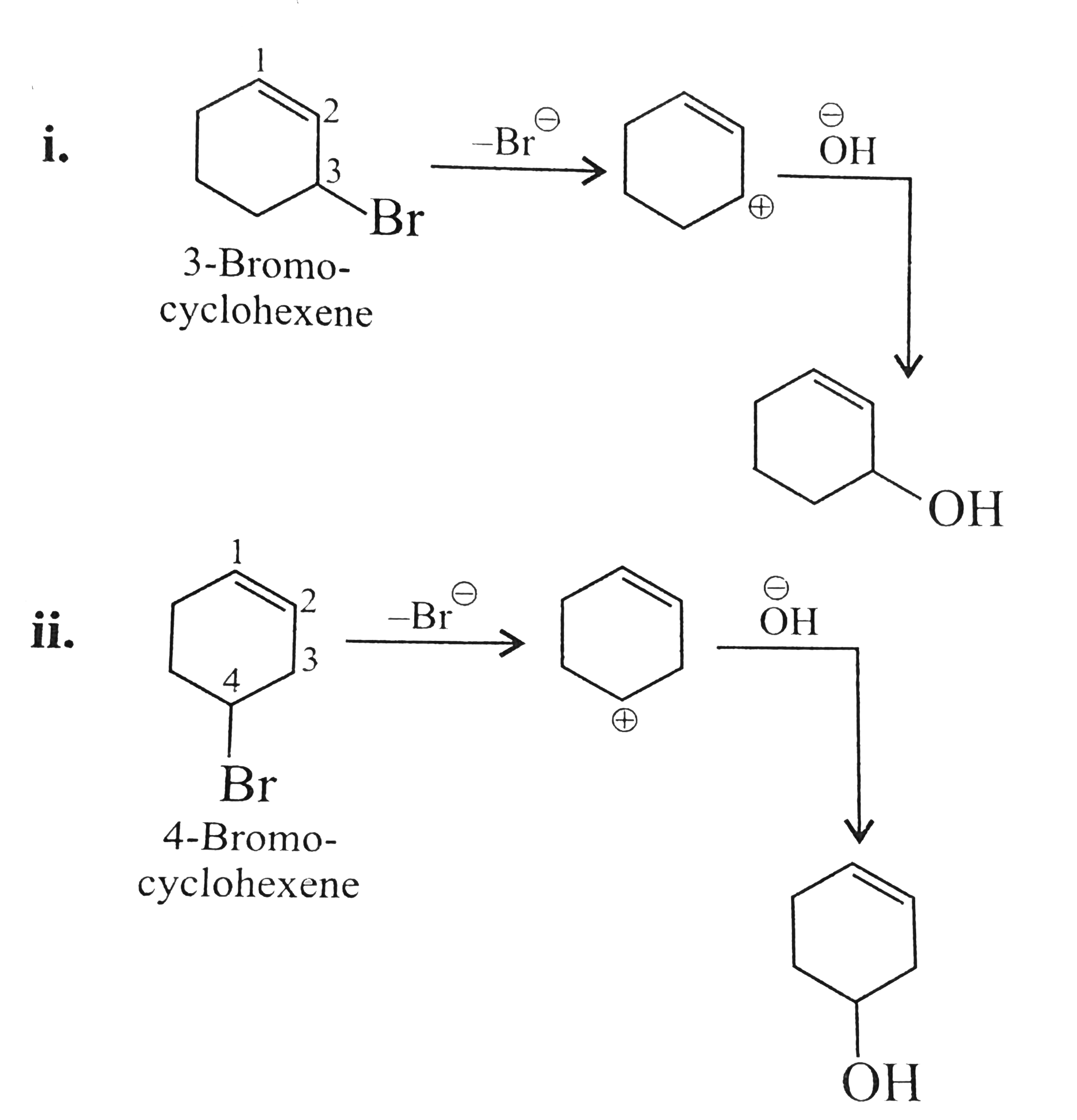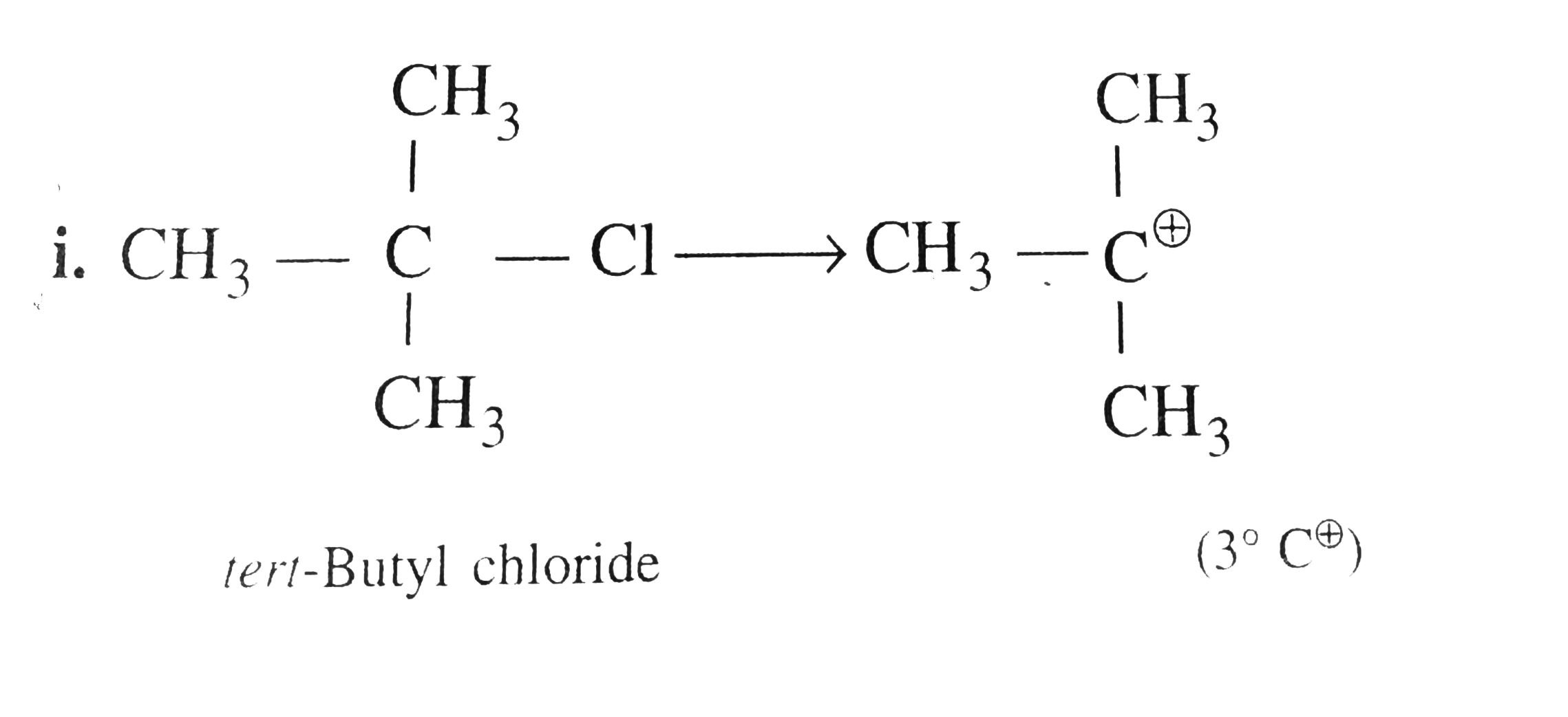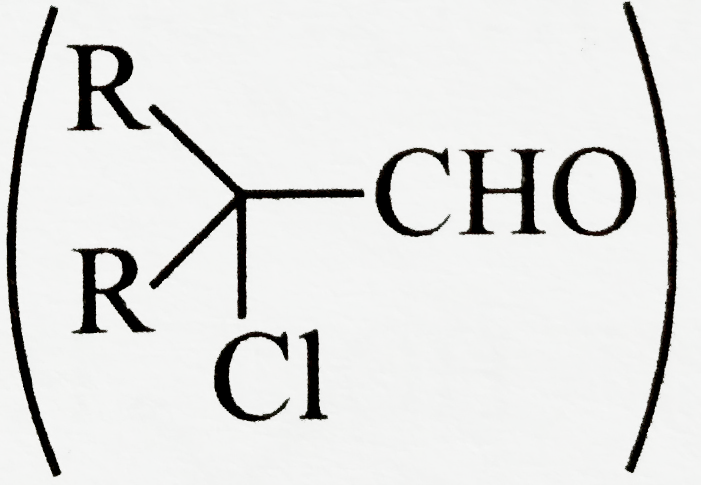Explain :
a. Vinyl chloride is unreactive in nucliphillic 4− subsitution reactions.
b. Neopenthyl bromide undergoes nucliphillic substituion reactions very slowly.
c. 3− Bromocyclohexane is more reactive than 4− bromovyclohexane in hydrolysis with aqueous NaOH.
d. ter− Butyl chloride reacts with aqueous sodium hydroxide by SN1 mechanishm while n− butuyl chloride reacts by SN2 medchanism.
a. Vinylic and aryl halides are unreactive towards SN reactions due to the resonance effects. Resonanace gives rise to partial double bond character to the (C−X) bond, making stonger and, therefore more diffcult to cleave than the (c−X) bond in RX(Rsp3−X) bond. It also reduces te polarity of the (cX) bond and, therefore, the heterolytic cleavage of (C−X) bond is difficult.

Neopentyl bromide gies (1∘C⊕) which can rearrange to 3∘C⊕ by 1.2, methyl shift, but is sterically hindered and so SN reaction takes place slowly.
C. 
(i) gives allylic carbocation, while (ii) gives 2∘C⊕ and allylic C⊕ is more stable than 2∘C⊕. So (i) more reactive than (ii) in hydrolysis with aq. NAOH.

ii. CH3CH2CH2CH2Cl→CH3CH2CH2(1∘C⊕)⊕CH2
Reactivity of SN1 reaction is 3∘C⊕>2∘C⊕>1∘C⊕ and reactivity of SN2 reaction is 1∘C⊕>2∘C⊕>3∘C⊕ . So (i) reacts with aq. NaOH by SN1 mechanism because it gives 3∘C⊕, while (ii) undergoes by SN2 reaction becuase it gives 1∘C⊕, ions.
Topper's Solved these Questions
- AROMATIC COMPOUNDS AND ALKYL AND ARYL HALIDES Book:CENGAGE CHEMISTRY ENGLISHChapter:AROMATIC COMPOUNDS AND ALKYL AND ARYL HALIDES Exercise:Exercises Subjective Type
Explore 5 Videos
- AROMATIC COMPOUNDS AND ALKYL AND ARYL HALIDES Book:CENGAGE CHEMISTRY ENGLISHChapter:AROMATIC COMPOUNDS AND ALKYL AND ARYL HALIDES Exercise:Exercises Subjective
Explore 17 Videos
- AROMATIC COMPOUNDS AND ALKYL AND ARYL HALIDES Book:CENGAGE CHEMISTRY ENGLISHChapter:AROMATIC COMPOUNDS AND ALKYL AND ARYL HALIDES Exercise:Solved Examples
Explore 21 Videos
- APPENDIX INORGANIC VOLUME 2Book:CENGAGE CHEMISTRY ENGLISHChapter:APPENDIX INORGANIC VOLUME 2Exercise:Short Answer Type
Explore 179 Videos
- BIOMOLECULESBook:CENGAGE CHEMISTRY ENGLISHChapter:BIOMOLECULESExercise:Exercises Archives (Analytical And Descriptive)
Explore 8 Videos
Similar Questions
What happens when : (write only chemical reactions)
(a) Hydrogen Sulphide is treated with Sulphur dioxide.
(b) carbondioxide is passed through a concertrated aqueous solution of sodium chloride saturated with ammonia.
( c) red lead is treated with nitric acid.
(d) dilute nitric acid is slowly reacted with tin.
View SolutionCompound (A), C8H6NOBr, is optically active. Reduction of (A) gives (B) which reacts with nitrouos acid to form (C), dihydric alcohol. Benzene sulphonyl chloride reacts with (B) to give a product soluble in NaOH. Hydrolysis of (A) gives (D) which is an optically active acid. (A) does not give any precipitate with aqueous AgNO3 . Controlled oxidation of (A) gives monobromo benzoic acid. Compound (A) on reaction with Br2/Fe gives only one compound. Identify (A), (B), (C), and (D).
View SolutionExplain:
a. α-Halocarbonyl compounds, even the 3∘ types like , do not undergo SN1 reaction.
, do not undergo SN1 reaction.
b. Which is more reactive: (i) PrCI or (ii) MeCOCH2CI with NaI/acetone ?
c. Acetals and ketals are regenerated back to carbonyl. compounds with H3O⊕ but not with ΘOH.
d. Cyclohexane is more reactive than cyclopenatone with HCN.
View SolutionExplain the following observations:
(a) Azide ion (N3) react with 2− bromopentane thousand times faster than with neopentyl bromide in a SN2 reaction through former is a secondary halide while latter is primary.
(b) What will happen to the stereochemistry of product of the following reaction:

(c) What will happens to the rate if the concentration of alkyl bromide in (b) is doubled?
(d) Wha will happen to the rate if the concentration of azide ion in (b) is doubled?
(e) How the sign of optical rotation of reactant and product are related in (b)
(f) When allowed to stand in dilute H2SO4 laevo-rotatory 2-butanol slowly loss optical activity.
View SolutionA white substance A reacts with dilute H2SO4 is produce a colourless B and acidified K2Cr2O7 solution produces a green solution and a slighly coloured precipitate D .The substance B to burns in air to produce a gas E which reacts with B ito yied D and a colouless liquid .Anhyhdrous copper sulphate is turned blue on addition of this colourless liquid addition od aqueous NH3orNaOH to C produce first a precipitate which dissolve in the excess of the respective reagent to produce a clear solution in each case identify A,B,C, and E. Write the equation of the reaction involved.
View SolutionWrite balanced redox reactions for each of the following reactions:
(a) Potassium dichromate (K2Cr2O7) reacts with hydroiodic acid (HI) to produce potassium iodide, chromium (III) iodide, and solid iodine, I2(s).
(b) A purple solution of aqueous potassium permanganate (KMnO4) reacts with aqueous sodium sulphite (Na2SO3) in basic solution to yield the green magnanate ion (MnO2−4) and sulphate ion (SO2−4).
(c ) Sn2+(aq) reduce IӨ4(aq) to IӨ(aq) and is oxidised to Sn4+.
(d) H2O2(aq) oxidises Mn2+(aq) to MnO2 in basic medium.
(e) H2O2(aq) reduces Cr2O2−7(aq) to green coloured Cr3+(aq) in acidic medium.
View SolutionAn organic compound A, C8H6 on reacting with dil. H2SO4 and HgSO4 gives a compound 'B'-which can also be obtained from reaction of benzene with acid chloride in the presents of anh. AlCl3 Compound B when reacted with iodine and aq. NaOH yields C and a yellow compound D. Identify A to D with proper justification.
View SolutionA white substance (A) reacts with dilute H2SO4 to produce a colourless suffocating gas (B) and a colourless solution (C )/ The reaction of gas (B) with potassium iodate and starch solution produce a blue colour solution. Aqueous Solution of (A) gives a white precipitate with BaCl2 solution which is soluble in dilute HCl. Addition of aqueous NH3 or NaOH to (C ) produced first a precipitate which dissolves in excess of the respective reagent to poduced a clear solution. Similarly addition of excess of potassium ferrocyanide to (C ) produced a precipitate (D) which also dissolves in aqeous NaOH giving a clear solution. Identify (A),(B),(C ) and (D ). Write the equation of the reactions involved.
View SolutionIdentify A, B, C, D and E.
A while substance A reacts with dilute H2SO4 to produce a colourless gas B and a colourless solution C. The reaction between B and acidified K2Cr2O7 solution produces a green solution and slightly coloured precipitate D. The substance D burns in air to produce a gas E which reacts with B to yield D and a colourless liquid. Anhydrous copper sulphate is turned blue on adiition of this colourless liquid. Addition of aqueous NH3 or NaOH to C produces first a precipitate
View SolutionSelect from the letters A to G the correct answer corresponding to the statements from 1 to 5:
A: Ammoniacal CuCl2, B: Trichloromethane, C: Trichloroethane, D: Bromine soln., E: Aqueous KOH F: Ethene, G: Sodalime, H: Ethanol, I: Ethyne.
1. The organic compound which forms carbon tetrachloride on reaction with chlorine.
2. The reagent which can distinguish between ethene and ethyne.
3. The substance which reacts with bromoethane to give ethanol.
4. The substance which gives bromoethane on reaction with hydrogen bromide.
5. The substance which reacts with acetic acid to give CH3COOC2H5.
View Solution